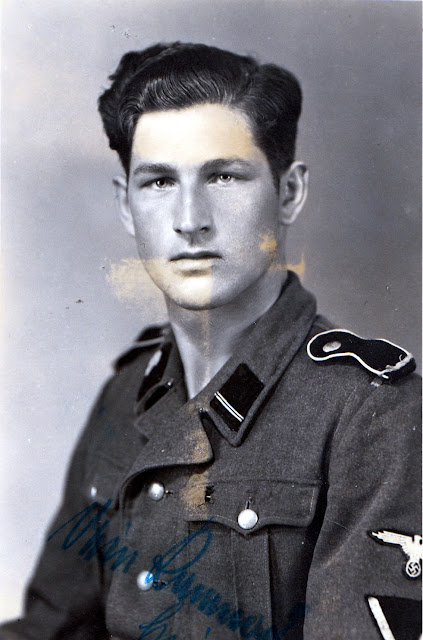Johannes Erxleben (1 April 1893 - 2 November 1972) joined the Telegraphen-Bataillon 5 as a Leutnant on March 22, 1913. On April 22, 1914, he was transferred to the Festungs-Fernsprech-Kompanie 3. When the First World War broke out, he led the Fernsprech-Zug of 33. Reserve-Division into the field. On October 9, 1917, he became divisional communications commander of the 33. Reserve-Division and on December 15, 1917, adjutant of the war telegraph department at the Chef des Nachrichtenwesens in Großen Hauptquartier. Promoted to Oberleutnant on September 20, 1918, he was transferred to the Kriegstelegraphen-Abteilung on November 9, 1918. Joined the Reichswehr on October 1, 1919, Johannes Erxleben became commander of the Reichswehr-Brigade-Nachrichten-Abteilung 6.. From April 1, 1920 to October 1, 1921, he was assigned to the Kavallerieschule Hannover. On January 1, 1921, he was transferred to Nachrichten-Abteilung 4. This was followed by the transfer to the Nachrichten-Abteilung 2 on January 1, 1923 and the return to the Nachrichten-Abteilung 4 on May 1, 1923. On December 1, 1926 he was then transferred to the artillery regiment 4 and as adjutant to the senior officer of the intelligence forces commanded to group command 2. On March 1, 1937, he was promoted to captain and on October 1, 1927, he was transferred to the staff of Gruppenkommando 2. From December 1, 1930, he served in the 2nd Company of Nachrichten-Abteilung 5, of which he became chief on February 1, 1931. From October 1, 1933, he was then a staff officer of the Nachrichtentruppen in the staff of the 2nd Division and from October 1, 1934 a staff officer of the Nachrichtentruppen in the military district command. On October 1, 1934, he was also promoted to major. On October 15, 1935, Major Erxleben took command of communications department 6 in Bielefeld, where he was promoted to lieutenant colonel on April 1, 1937. From November 10, 1938 he was then commander of the XIII intelligence forces. With the start of mobilization on August 26, 1939, Lieutenant Colonel Erxleben Leider became the evaluation point at Army Group C and on September 25, 1939, Field News Commander 11. From October 1, 1939, he was then News Commander of Posen and from February 6 1940 Commander of the Army News Regiment 549. On April 1, 1940, he was promoted to colonel and on October 25, 1940, was appointed news leader of the 11th Army. From March 5, 1942, he was news leader of the 12th Army, on January 23, 1943 converted to news leader of Army Group E. On February 25, 1943, he was appointed news leader in southern France and after his promotion to major general on October 1, 1943 to the higher news leader zbV 513 on November 1, 1943. On June 25, 1944, he was transferred to the Führerreserve and on August 1, 1944, he was entrusted with the maintenance of the affairs of the Wehrmacht commander in Kassel. He then officially took over this post on September 15, 1944. The command post of the commanding general was the vineyard bunker. Kassel, which was completely destroyed by 40 air raids, was declared a "fortress" as the last major Hessian city. "Kassel will be defended to the last man," was the slogan. When the 80th US Infantry Division advanced in an encircling movement from the south towards Kassel in the first days of April, German soldiers blew up the Fulda bridges. According to a contemporary witness report by the defense, court and orderly officer Dirk Uhse at the time, he became the commander of the "fortress Kassel", Colonel General Johannes Erxleben, on the night of April 3rd, 1945 as a parliamentarian American troops stationed on the southern outskirts of the city with the task of obtaining free withdrawal for the Wehrmacht units located in Kassel, but at least for the civilian population. When the American general refused and announced that "the fight would either be surrendered or the fighting would continue", Uhse decided - without consulting Erxleben - to surrender. Major General Erxleben was taken prisoner, from which he was released on June 6, 1947.
Source :
https://www.ebay.de/itm/WW-2-General-Johannes-Erxleben-Nachrichtenfuhrer-in-Frankreich-1944-45/274454391716?_trkparms=aid%3D1110006%26algo%3DHOMESPLICE.SIM%26ao%3D1%26asc%3D20200818142525%26meid%3D71d5f394ca3f4032ad2ceaae5c987819%26pid%3D101195%26rk%3D4%26rkt%3D12%26mehot%3Dco%26sd%3D273809192918%26itm%3D274454391716%26pmt%3D1%26noa%3D0%26pg%3D2047675%26algv%3DSimplAMLv5PairwiseWebWithBBEV2bDemotion&_trksid=p2047675.c101195.m1851


















































